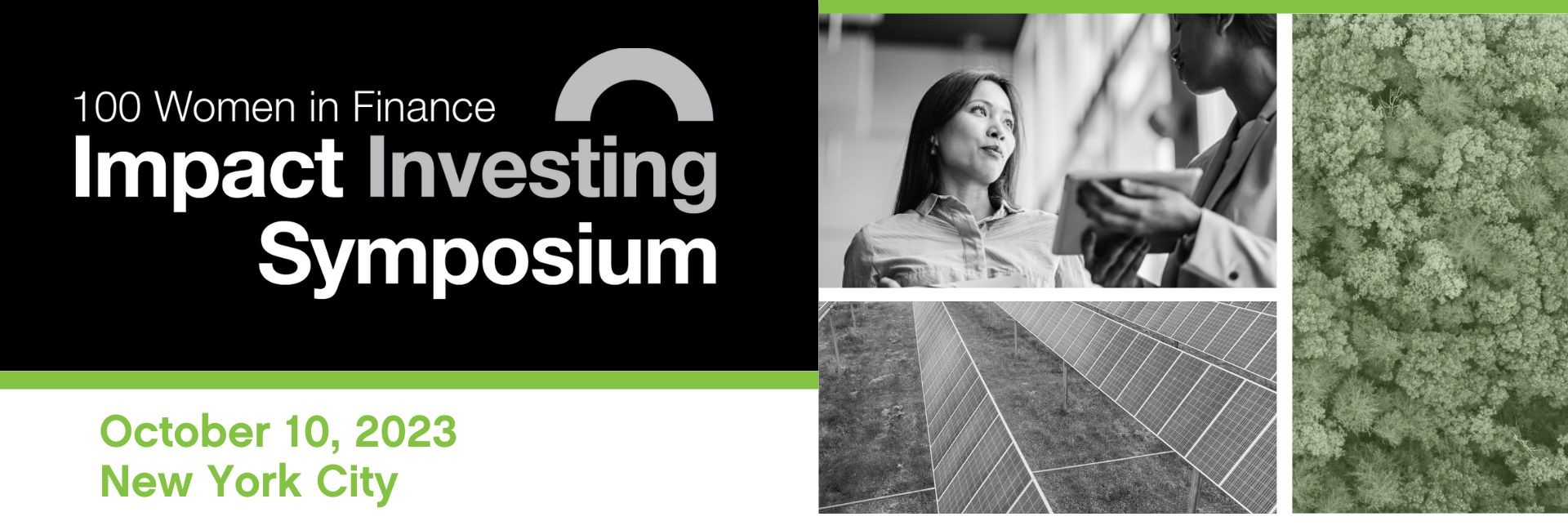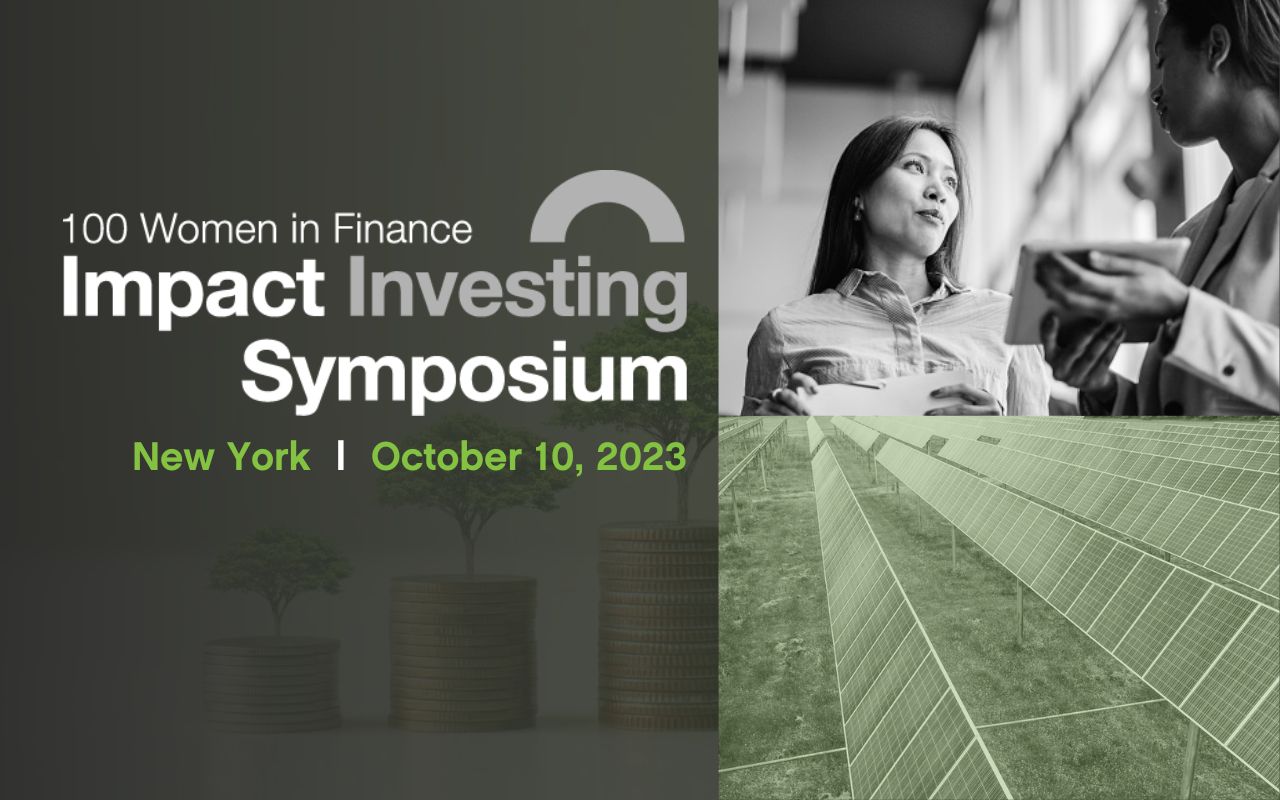
In the run-up to 100 Women in Finance’s inaugural hosting of an Impact Investing Symposium on October 10, 2023, in New York City (previously presented annually by High Water Women since 2013), Karyn Polak, Founder and President of Shift the Prism Advisory, and 100WF Impact Investing Symposium committee member, conducted a virtual panel discussion with some of our exceptional speakers for the event.
Caroline Abramo is the Founder and CEO of Pana LCE Investments, which funds companies and advises businesses on greenhouse gas reduction. Beata Kirr is the Chief Impact Officer for The Copia Group, a lower middle market lender in the private markets. Paula Luff is the Director of ESG Research and Engagement at DSC Meridian, a firm that provides investors with ESG-integrated credit exposure.
I hope you’ll enjoy our conversation. Featured speakers and additional event info can be found here.
[Karyn/Moderator]: Many people don’t even recognize the term “impact investing” and those who do often use different terms to describe it and may have different conceptions of what it even is. So, let’s start with how each of you define “impact investing.”
[Caroline]: Investing that is both measurable and scalable: Measurable, meaning we can quantify and evaluate the impact we make on the world as we invest, and Scalable, meaning leveraging investments for the solutions to some of our largest economic and societal problems.
[Beata]: Impact investing is about the intentionality of making a difference on environment or societal goals that go above and beyond financial return. It is a forward-thinking mindset that considers multiple stakeholder perspectives.
[Paula]: We define impact investing as generating superior risk-adjusted returns while also having real-world impact on the sustainability practices, outcomes and strategy of our investee companies. We believe that integrating into our investment process material sustainability factors that can impact valuation and cost of capital, and engaging directly with our portfolio companies on those factors, generates value for both our investors and our portfolio companies.
[Karyn/Moderator]: That’s helpful context. Other than Caroline, who leads her firm’s work as CEO, what is your role within the impact space at your firm?
[Beata]: In my role as Chief Impact Officer, I am squarely focused on ensuring that there is an impact case for investment alongside a financial case. We take a dual diligence approach that is incorporated at every step in the investment process. My most important role has been defining how we will assess and measure the social impact we are seeking to make. In addition, I focus on thought leadership, deal sourcing, and our investment underwriting work.
Our theory of change is focused on narrowing the wealth gap for women and ethnically diverse populations, whose equity and business ownership are both far smaller than their population representation. The largest driver of wealth gap differences over time is asset ownership, and asset ownership is hard to achieve without reliable and flexible access to credit. At Copia, we are focused on helping diverse lower middle market business owners or businesses catering to diverse populations to finance their growth. We believe that business growth will have a multiplier effect across key stakeholders, including their employees, suppliers, and community. My role is to work with those business owners to identify the key metrics to track that impact and implement those measurement processes.
[Paula]: I am embedded in the investment team and work closely with our Chief Investment Officer and the analysts in the underwriting process to understand the risk and value drivers of material sustainability factors at the company level. I also engage with and advise companies on improving sustainability disclosure and integrating sustainability into their strategy and operations, with an eye toward unlocking value.
With companies in our Climate Action Fund, we take this work a step further and help set companies on a glide path to alignment with the Paris Agreement [a legally binding international treaty on climate change adopted by 196 parties at the UN Climate Change Conference (COP21) in 2015].
[Karyn/Moderator]: What’s one area of opportunity in impact investing you’d like to highlight?
[Paula]: Following closely on the heels of Climate Week, I’d say climate change and the move toward decarbonization present both enormous risks and opportunities. We need to focus on decarbonizing hard-to-abate sectors like shipping, materials, and aviation and invest in and scale new technologies focused on resilience and adaptation.
[Caroline]: I’ll second the vote for climate investing. Net Zero goals [cutting greenhouse gas emissions to as close to zero as possible, with any remaining emissions re-absorbed from the atmosphere] and climate pledges represent approximately $100-300T in macro spend. Climate impact investing is quite possibly the largest opportunity in our lifetime. I’ll reiterate Paula’s statement that climate impact returns are attractive. We are targeting 20+% market rate risk-adjusted IRRs over 5-7 years, and those are financial returns. But overall, we are focusing on Strategic, Impact, and Financial Returns. We aim to achieve these returns by focusing on technologies in real asset sectors (Energy, Industrials, Agriculture, Real Estate) with high operating margins driven by low-cost feedstocks and green premiums. We recognize climate as a huge area of impact over centuries as well as a new driver of growth in the economy.
[Beata]: Private credit is a relatively new asset class for many investors, given the substantial growth it saw after the major regulatory changes of the Global Financial Crisis. Whereas banks used to represent 70% of the lending market for lower middle market businesses, they are now close to 10%. And while the number of private credit players has grown substantially, impact private credit has been a very small percentage of this universe. There is a real opportunity to define and expand impact in this relatively untouched space.
Sustainability-linked private loans have been few and far between, yet in the public markets, Green Bonds [debt securities designated to finance environmentally friendly projects] have become a significant offering. There is an opportunity to create that space for impact in private credit as well, by defining success for loans differently including impact KPIs [Key Performance Indicators] alongside credit metrics as necessary covenants in the underwriting process.
[Karyn/Moderator]: Those examples are energizing for sure. And yet there are many misconceptions and confusion that circulate about impact investing. What’s one myth you’d like to bust for people?
[Paula]: First and foremost is the myth that impact investing is inherently returns-concessionary.
[Caroline]: Yes! We constantly try to bust the myth that impact investing cannot make a lot of money. Impact investing is scalable, and the most sustainable companies are the most profitable. Sustainability is achieved through investment in so many areas — DEI [Diversity, Equity, and Inclusion], health, education – and of course climate, which scales through all impact areas. While a focus on bottom-line profits and earnings is necessary in any kind of investment, impact investing brings not only opportunity for humanitarian benefit but also tremendous financial growth.
[Paula]: I’ll add a second myth – that impact investing is easy! [You’ll need to join us for the Symposium to help make it easier…]
[Beata]: An emphatic “seconded” to both of these myths!
[Karyn/Moderator]: Great! Well, then, Paula, I’ll take the bait and throw it out to the group. What’s one of the greatest gaps or challenges in advancing impact investing, in your view?
[Caroline]: The greatest challenge in advancing climate impact investing is what we at Pana like to call the “Valley of Death” – the gap in funding for growth between Venture Capital and Infrastructure Investing. We focus on this area because the <20% of sustainable companies that make it to a series B round out of venture capital investment often have problems with growth and with scaling their revenue and, therefore, their impact. To create meaningful impact and financial returns, companies need private funding to survive this Valley of Death.
[Paula]: I think we focus too much on process metrics as opposed to measurable outcomes, reports and policies as opposed to changes in operations and strategy. We also do a terrible job of telling our story as evidenced by the current ESG [Environmental, Social, and Governance] backlash. We need to explain in decoded terms what we do and why it adds value to our investors, portfolio companies and other stakeholders.
[Beata]: I agree with the backlash issue, Paula. Whether you are an ESG investor or an impact investor, the greatest challenge today is moving away from the history of ESG evolution to a new normal, where ESG is not a separate team or separate reporting line, but rather is fully integrated into the portfolio management process – and just as integral to it. Once we equate ESG/impact measurement to the risk and opportunity that is so often discussed in the risk-adjusted, mission critical return discussion for an investment, it will become part of the mandatory conversation, rather than the often-perceived “side by side” process.
[Karyn/Moderator]: Sounds like a third myth to highlight, which is that impact investing is the same as investing with ESG factors in mind – in fact, the former is about intentional, purposeful investing for specific outcomes, whereas the latter is about screening out or in companies that are doing better or worse at integrating important risks into their business practices and strategy. So, let’s offer some resources to help further people’s understanding of and engagement with impact investing. Share with us one individual, organization, or initiative advancing impact investing outside of your own work that you’d like to highlight, and/or one resource you regularly refer to or refer people to for information on impact investing.
[Caroline]: I’d offer the Task Force on Climate-related Financial Disclosures. The TCFD publishes publicly available recommendations and guidelines on how to report climate-related financial information. Another great resource is Project Drawdown, an organization that develops and informs on climate solutions, strategies, and investments.
[Paula]: When I was leading access to medicines at Pfizer, I had the opportunity to meet with investors like Calvert, Domini and other members of ICCR [the Interfaith Center on Corporate Responsibility]. Those conversations were hugely valuable in shaping my early thinking about the role of business in society. My involvement with the Aspen Institute’s Business and Society Program, led by Judy Samuelson, has also been career-shaping both because of what I have learned and the people I have met along the way.
[Beata]: I’d suggest the IMP [Impact Management Platform] curriculum. It is an ongoing reference for best practices in impact measurement. The IRIS+ framework tool [a generally accepted system for impact investors to measure, manage, and optimize their impact] is excellent and allows you to solve for the most appropriate KPIs for your theory of change. It forces you to really focus on what’s important to you – and ensures you’re measuring the most impactful KPIs for that focus area.
[Karyn/Moderator]: That’s a great place for us to leave it – highlighting that you can, in fact, invest with a focus on what matters most to you and truly play an active role in shaping systems, communities, and people’s lives through the agency you have with your assets. That’s the real power of impact investing!

